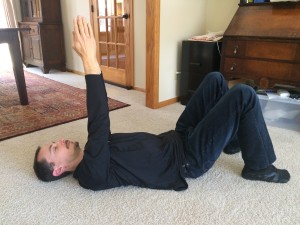Coordination of the Flexor Muscles and of the Extensors (Patrons)
After exploring this lesson at least once try our Essence for “Experts” half-hour version.
Lying on the back, knees bent, one or both feet standing, variations on tilting crossed legs and "triangle" arms/shoulders in order to twist and untwist the torso, learning more awareness, control, and coordination of the major flexors (folding muscles) and extensors (arching muscles).
We offer over 50 free lessons, but this one's just for our Patron-level donors. You can learn about it in the free lesson notes and comments below, but to access the audio you’ll need to join The FP as a Patron. Learn more
Donor Tip: Skip this login next time! See Why & How to Stay Logged In (and why it's safe)
Got a question for Nick, or a thought about this lesson?
Use the comments section below! Public comments build our community and help search engines find us.





This is great! I was taking an Awareness through Movement class in The Villages last fall & loved it, but the instructor became very ill & there’s no one to teach the classes anymore. Finding your website is wonderful!
This lesson stops at the 16:32 minute. 🙁
I wasn’t able to recreate this problem. You may have had a momentary internet outage, or perhaps it was a hiccup on my end. Please do let me know if it happens again. In the meantime, rebooting your browser fixes any technical issues people have had with my site about 99% of the time! Thanks for listening.
Hi Nick, I want to thank you for your ATMs. I live in Australia and although there are many felde classes and practitioners available, I enjoy your classes more than any I have attended locally. Your clear instructions and reminders are easy to follow, and it is so convenient to login and choose something that feels relevant to what I need at any given time. Once again, thanks.
I too am in Oz, and love Nick’s lessons. I’ve learned from some very good people, and have done a number of variations of this lesson. Nick’s directions are such that i keep discovering new movements, mobilities and connections. When i get up and walk around, all my joints feel OILED!
I love this lesson. Your presentation is faithful to the original. Nevertheless you bring something more to the presentation. I am grateful to Moshe for developing and sharing his insights but aware that we have learned even more in the intervening years and a classic lesson makes this clearer to me.
WoW what a great lesson!!
My head kept getting further up the floor.Jean Kirk.
The word that came to mind at the end was “integrated.” I felt like I was more connected head to toe. I also felt like I’d had a workout!
I enjoyed this lesson for many of the same reasons I enjoy a lot of them: I feel like it increases the fluidity and articulation of my torso, ribs, scapulars, etc., which have been somewhat “frozen” as a result of injuries that have accumulated as I have used my body pretty hard (white water canoeing, dancing, running, hiking, working out) and aged (now 62). Also, I love that you remind us to look for the pleasurable feelings in movement because we are already very good at focusing on the painful ones. It’s like letting my body remember how joyful it used to feel, and finding those sensations again. To me this is the greatest “gift” of the ATMs and the way in which your narration guides me through them.
It’s interesting that in this particular narration you keep reminding us that we may not need to use the lumbar arch and can instead let the weight into the floor relax and strengthen our movements. I didn’t find my lumbar region had any desire or tendency to arch, but I did notice that I had to keep returning some attention to my jaw to keep it relaxed during the head-lifting parts of the sequence.
The lumbar arch and region around my sacrum had been the most vulnerable part of my body till last year, somehow I found the key to solve my problem.
P.S., I am in Berkeley, CA, not Oz, but want to echo others that Nick’s narrations/interpretations of ATMs are an order of magnitude better, clearer, and deeper, than any I’ve encountered in the the four or five other practitioners I’ve tried. I also really like doing them on my own time, in my own space. Often I listen to a new ATM first as I’m in bed getting ready to sleep, going through what it would probably feel like mostly in my mind. Then, if it seemed interesting, as most do, I do it “for real” (i.e., not in bed) a day or two later. This seems to help me avoid the tendency to “strive” too hard when I actually do the ATM because I’m already more attuned to seeking the nuances of the movements. Recently I had a short series of hands-on one-on-one sessions with a very good local practitioner to help me problem-solve some specific issues and after each session I found one or more of Nick’s ATMs that perfectly complemented the one-on-one sessions.
Lovely lesson, I always enjoy the proprioceptive experience of twist lessons. I usually try not to give words to the sensations, but considering the class was asked to at the end I figured I’d give it a go, the closest I can come is feeling “lighter”.
The judo remarks made me remember something from my youth I hadn’t thought of in a long time. I did judo from age 7 to 14, and as a teen one time I fell head first from quite high onto concrete, something that should’ve caused severe damage. I had and have no recollection of the actual fall, but bystanders saw me break the fall smoothly (in their words “you did a judo roll”) and I was completely fine. Thinking about that now I feel like it’s a great example of sensorymotor learning at work. No conscious cognitive effort was needed to put into practice the motor skills I’d acquired during my years of judo, the body just automatically knew what to do without any conscious decision making. So it doesnt pertain to the contents of the lesson perse, but jjst that remarks triggered a great reminder to me as I recover from chronic illness, that I can trust in my body’s capacity to organise itself.
I appreciate your insights on your Judo experience when you fell, and the relationship to practicing Feldenkrais. Sometimes I wonder if I need to put effort into my everyday movements to maintain what my body learned in an ATM lesson . Your comment reassured me that I can trust in my body’s wisdom, while embracing my surprise moments of awareness when they show up!
Thank you, and thank you Nick!
The differentiation in this lesson is incredible. I have been unwinding scoliotic patterning for the last 8 or so years, and I notice a LOT of stiffness in my rib basket, shoulder girdle, and lower back. It is interesting what I have learned about my body from these lessons, and I am finally at the point where I can do this kind of mid twisting and it helped me learn so much!
Feldenkrais helped me notice that I was chronically bracing in my left hip, which I had no idea I had been doing. In this lesson I was very aware of how I would press my feet into the floor and activate the hip to counterbalance or compensate for the twists, and I was able to continually relax the left hip and intentionally press my right foot into the ground instead to play with it and see what happened. Curious if I can change my brain so I’m giving it a try! Thanks!
Great lesson! I noted in the first part, while tilting the legs, that it is possible with only using the foot (without using the belly muscle) and also vice versa. The aim is probably a mixture of both, right? I am someone with not much sense for what muscle is sensible to use, so I am somewhat lost, if there is no explicit instruction what muscle to use (although I understand, that it is one of the main points of Feldenkrais lessons, to figure out by oneself).
It’s true we almost never “target” specific muscles, because that’s not how spontaneous movement happens, feels, or is regulated as we live our lives normally. At the very beginning of the leg tilting it may be that your movement was so small that you could tip and return the legs just by manipulating the edges of your foot. But after the knees have moved more than a couple inches, you actually have to use core muscles to return them to balanced. That’s the physics of it, but you may not have found awareness of this engagement yet. It may be helpful to follow skeletal landmarks closely: the relationship of your sacrum to your ribs on either side of your back, for example.
As you said at the end, it’s not necessary that you “figure it out” consciously in order to improve.
🙏 My body remembered ,with pleasure, doing this lesson from 40 years ago !
Nick’s delivery was a beautiful – helping me to return to sensations of joy , balance and strength , that have been buried beneath many years of stress and tension. My spine feels looser and longer now and my left hip joint , which has been bracing forward for years, feels way more relaxed. .
Thank you 🙏